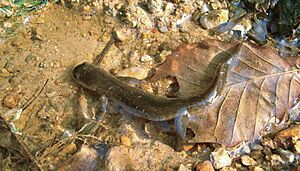Kori salamander facts for kids
Quick facts for kids Kori salamander |
|
|---|---|
 |
|
| Conservation status | |
| Scientific classification | |
| Genus: |
Hynobius
|
| Species: |
yangi
|
The Kori salamander (scientific name: Hynobius yangi) is a special type of salamander. It lives only in southeastern South Korea. It looks a bit like the Korean salamander (H. leechi). But you can tell them apart by their tail shape and the color on their back. These salamanders are found near Gijang County in Busan and Ulju County in Ulsan. They like to breed in still water.
Contents
How the Kori Salamander Got Its Name
The Kori salamander gets its common name from a place called Kori. This is a rural area in Gijang County, northern Busan. It's the first place where this salamander was officially found.
Its scientific name, Hynobius yangi, honors a Korean scientist. This scientist, Suh-Yung Yang, studied amphibians and reptiles.
What the Kori Salamander Looks Like
Male Kori salamanders are usually about 42 to 63 millimeters long. This is measured from their snout (nose) to their vent (a small opening near the tail). Female salamanders are a bit longer, about 57 to 61 millimeters.
Their tail is quite long. It's about 70% to 90% of their body length. Males often have longer and taller tails than females.
The color on their back is usually olive green. Some might be dark brownish. They might have very tiny yellow dots. Their underside, or belly, is lighter in color.
Life Cycle and Reproduction
Kori salamanders breed in late winter to early spring. This happens from late February to late March. They lay their eggs in still water, like ditches.
The eggs are laid in special sacs. These sacs are shaped like coils. One female salamander was found to lay 86 eggs. Each egg was about 2.8 millimeters wide. The egg sacs are often attached to water plants or fallen branches.
Where the Kori Salamander Lives and Why It Needs Help
The Kori salamander lives in hilly forest areas. They need still water, like ditches, for breeding. They attach their egg sacs to plants or branches in these waters.
The IUCN (International Union for Conservation of Nature) has listed the Kori salamander as "Endangered". This means it is at high risk of disappearing forever. There are two main reasons for this. First, they live in a very small area. Second, their natural homes are being lost. This loss of habitat is a big problem for their survival.
See also
- List of amphibians of Korea
- Korean crevice salamander


